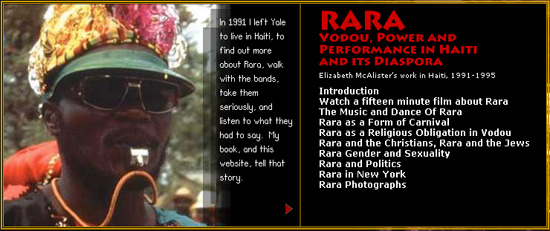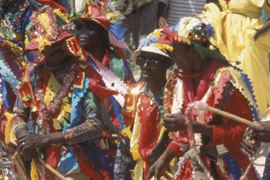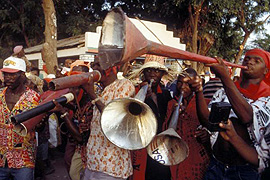Web Site Teaches Haitian Celebration Through Text, Sound, Video
 |
| A new learning objects tool, designed by Associate Professor Elizabeth McAlister, features multimedia tools to help teach the story of Rara. |
| Posted 01/17/07 |
| In Haiti, the people celebrate their African ancestry and religion with a Rara festival, a culturally rich musical and dance event.
Elizabeth McAlister, associate professor of Religion and chair of the Religion Department, associate professor of African American studies, and associate professor of American studies, has studied this tradition for 15 years. Through a newly-created teaching tool, she hopes people can gain new insights on the Rara festival. Designed by Wesleyans Learning Objects Studio staff, the Web site, http://rara.wesleyan.edu/ is available for academic and public use. The site is already being used at classes at New York University and Swarthmore. “My hope is that people interested in Rara, students, musicians, artists, travelers and other researchers, will be able to use this Web site as an interactive study guide, McAlister says.
After my book on Rara came out, internet technology made it possible to display the photographs and videotape that I made in Haiti, together with my friends and collaborators, she explains. Through the online tool, McAlister posted a 15-minute film about Rara, music and dance clips. She included images, video and audio clips of Rara as a carnival; Rara as a religious obligation in Vodou; Rara and the Christians and Jews; Rara gender and sexuality; Rara and politics; and Rara in New York City. In each section, McAlister includes media, notes from the field, and an analysis, often adapted from her book. When explaining Rara as a form of carnival, McAlister explains, in the analysis, that the tone, or ambiance, of Rara parading is loud and carnivalesque As in Carnival, Rara is about moving through the streets, and about men establishing masculine reputation through public performance. Rara bands stop to perform for noteworthy people, to collect money. In return, the kings and queens dance and sing, and the baton majors juggle batons-and even machetes! The site includes clips on several Rara bands including La Belle Fraicheur de l’Anglade in Fermathe, Mande Gran Moun in Darbonne, Rara La Fleur Ginen in Bel Air, Rara Inorab Kapab in Cite Soleil and Rara Ya Seizi.
The music featured on the Web site was produced by Holly Nicolas, postal clerk, and mixed and mastered by Peter Hadley, conductor of Wes Winds. McAlister, who lived in Haiti to study Rara, says she walked with the bands, took them seriously and listened to what they had to say. My book, and now this Web site, tell that story, she says. For more information on the Learning Objects Studio go to: http://learningobjects.wesleyan.edu. |
| By Olivia Drake, The Wesleyan Connection editor |


 McAlisters interest in Rara dates back to 1991 when she began researching Haitis vibrant culture, often celebrated through Rara. In 2002, she published a book titled, “Rara! Vodou, Power and Performance in Haiti and its Diaspora.” The Web site serves as a companion piece to her book on Rara.
McAlisters interest in Rara dates back to 1991 when she began researching Haitis vibrant culture, often celebrated through Rara. In 2002, she published a book titled, “Rara! Vodou, Power and Performance in Haiti and its Diaspora.” The Web site serves as a companion piece to her book on Rara. Donning traditional Rara costumes, which are known for their delicate sequin work and vivacious colors, dancers are shown in action, in low or high bandwidth videos of dances and music. In one clip, a queen and two kings dance the mazoun. Traditional instruments such as bamboo and the paper-fabricated konet are shown in several accompanying images like the one at right.
Donning traditional Rara costumes, which are known for their delicate sequin work and vivacious colors, dancers are shown in action, in low or high bandwidth videos of dances and music. In one clip, a queen and two kings dance the mazoun. Traditional instruments such as bamboo and the paper-fabricated konet are shown in several accompanying images like the one at right.